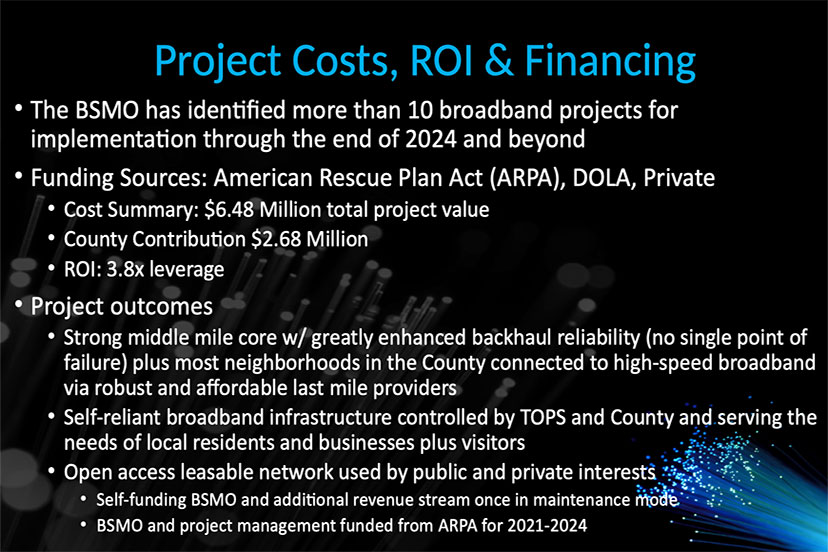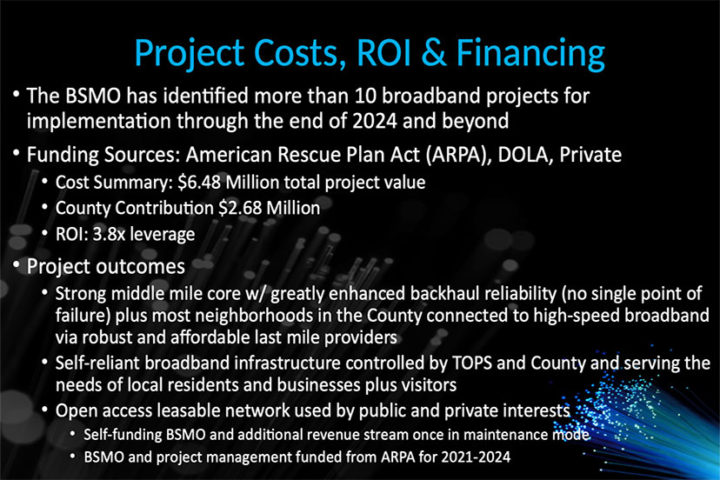We are listening here to Jason Cox, co-manager at the non-profit Broadband Services Management Office (BSMO), presenting a ‘strategic plan’ of sorts to the Archuleta Board of County Commissioners at a June 1 work session. Mr. Cox had prepared an 11-page Power Point slideshow to outline how the BSMO could help the County spend $2.68 million over the next couple of years.
Mr. Cox was appearing at the work session via Zoom, and he apologized, jokingly, that his internet connection was “unstable”.
“Really, most of the projects here are slated to be finished by the end of 2024, if we get an injection of cash from the ARPA or something else. Other wise it would take longer because… well, there’s no romance without finance. We gotta have money to make these projects happen. We’re going to be able to leverage a lot of these, working with public and private entities.
“And, again, the goal is that we have a modern, high-speed infrastructure for businesses, residents, and visitors…”
“We do need to ‘seed’ this with ‘skin in the game’, meaning, if you’re going to invest in these projects and want to get money from the state and the feds, they want to see that you have a little bit in it, as well. We have an opportunity with ‘remote work force’ that’s pretty amazing; we’ve all seen it in the real estate markets and just driving around the community. People are interested in relocating and living in Pagosa. That’s an attractive opportunity, versus some of our issues with second-home owners, who contribute but aren’t primarily supporting the economy, living somewhere else…”
Perhaps the main argument here, as presented by Mr. Cox, is that Pagosa’s tourism-based economy — so eagerly promoted by local governments these past couple of decades — is showing signs of age, and infirmity? And if we spent $2.68 million on broadband projects, we might become a ‘destination’ for tech workers earning sufficient salaries to afford a $450,000 median-priced home here.
I’d heard the rumor — or maybe it wasn’t a rumor — that the Archuleta County government was expecting a gift of $2.7 million, resulting from the federal American Recovery Plan Act, also known as ‘ARPA’. The US Congress and the President, in their wisdom, were digging deeply into the future pockets of our children and grandchildren to create trillions of dollars of additional federal debt, to address the economic damage from the COVID-19 public health policies.
And a portion of that magic money, created out of thin air, was destined for local government bank accounts.
We understand that the Archuleta BOCC had not asked for this money. Nor had Pagosa’s local governments suffered financially due to the COVID pandemic. In fact, both the Town and County governments ended the 2020 fiscal year with a budget surplus from record sales tax collections. It seems that the local residents in Pagosa, and the record number of tourists who visited over the 2020 summer season, had bought stuff like money was going out of style, and two of the main beneficiaries of that spending spree were the Town of Pagosa Springs and Archuleta County.
(We will not address the question of whether money is, in fact, going out of style. That discussion will have to wait for another day.)
So… how to spend a $2.7 million windfall? We can imagine the creative thinking going on at the Archuleta County Administration Building on Lewis Street, as our three elected commissioners and their staff discussed ways to spend almost $3 million they hadn’t expected to receive, and maybe didn’t really need.
Congress had naturally placed some controls on the “Fiscal Recovery Funds” distributed to state and local governments, and in his presentation on June 1, Mr. Cox implied that the only thing Archuleta County could legally finance with the $2.7 million windfall was “broadband”. So the BSMO had come up with a plan — apparently, at the request of the BOCC — to help our County government spend the entire amount over the next three years… solely on ‘broadband’.
I had not heard that the ARPA funds were quite so limited in their application.
From the May 17, 2021, Federal Register:
Sections 602(c)(1) and 603(c)(1) provide that funds may be used:
(a) To respond to the public health emergency or its negative economic impacts, including assistance to households, small businesses, and nonprofits, or aid to impacted industries such as tourism, travel, and hospitality;
(b) To respond to workers performing essential work during the COVID–19 public health emergency by providing premium pay to eligible workers;
(c) For the provision of government services to the extent of the reduction in revenue due to the COVID–19 public health emergency relative to revenues collected in the most recent full fiscal year prior to the emergency; and
(d) To make necessary investments in water, sewer, or broadband infrastructure.
The Federal Register goes on the describe, in some detail, the various allowed applications for the windfall funding… including but not limited to:
- Assistance to Households.
- Building Stronger Communities through Investments in Housing and Neighborhoods.
- Expenses to Improve Efficacy of Economic Relief Programs.
- Behavioral Health Care.
- Expenses to Improve the Design and Execution of Health and Public Health Programs.
- Eligible Uses to Address Disparities in Public Health Outcomes.
- Impacts on Businesses.
- Exacerbation of Pre-existing Disparities.
- Water and Sewer Infrastructure.
- Broadband Infrastructure.
Yes, ‘broadband’ improvements are among the allowable use for the ARP funds. And, yes, we do have a non-profit ‘Broadband Services Management Office’ that has received inconsistent taxpayer funding over the past couple of years, run by two rather-well-paid co-managers.
But as I have pointed out occasionally — in past Daily Post editorials — we have hundreds of people living in Pagosa Springs who do not have running water or central sewer services. We have hundreds of employees who may work two or three jobs, but who currently have no home to call their own, and who are living in unheated sheds, tents, vehicles…
Is “faster broadband” really the most pressing, $2.7 million, need in the community?
Would “faster broadband” in fact benefit a tiny segment of our Pagosa employed population… while a much larger group continues to live in poorly heated dwellings, with no running water?


